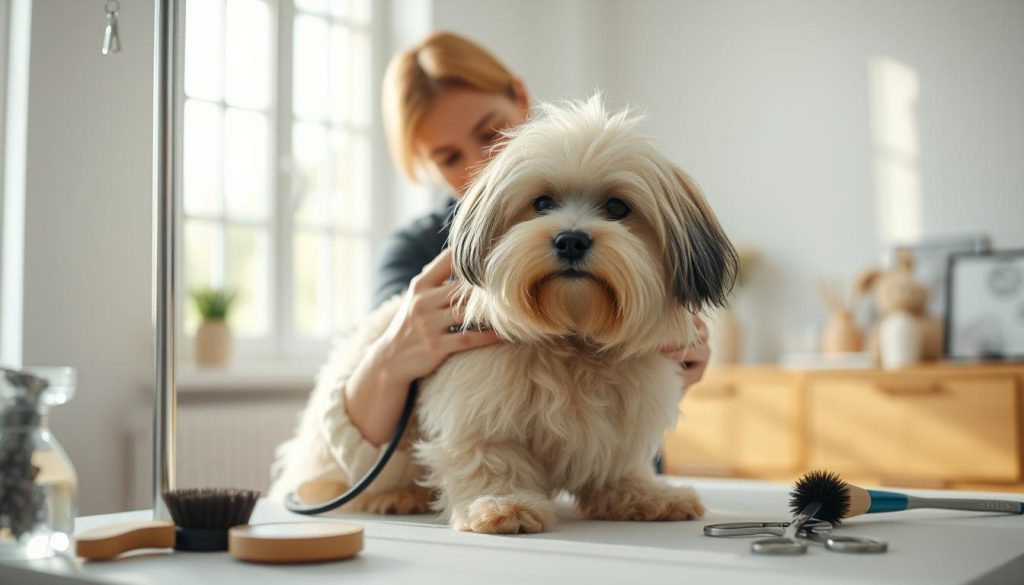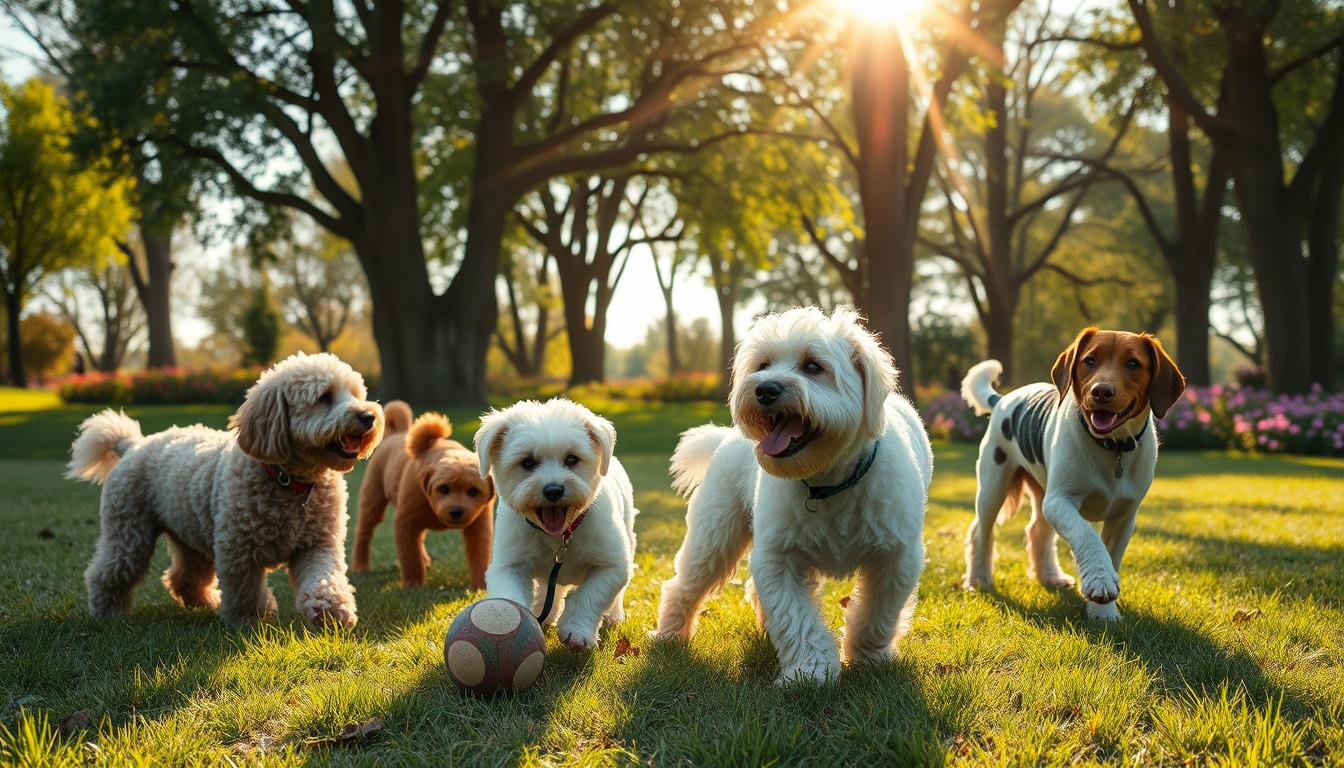As someone who suffers from allergies, finding a pet can be tough. But, there are many hypoallergenic dog breeds that can be great companions. They won’t make you sneeze and sniffle. In this guide, I’ll show you the best hypoallergenic dogs and how to make your home allergy-free.
Understanding Hypoallergenic Dogs
If you have allergies, you might have heard about “hypoallergenic” dogs. But what does this term really mean? And why do some dogs suit people with allergies better than others? Let’s explore the truth about hypoallergenic dogs.
What Makes a Dog Hypoallergenic?
Hypoallergenic dogs make fewer allergens like dander, saliva, and urine. These are the main causes of dog allergies. Even though no dog is completely hypoallergenic, some breeds are less likely to cause allergies. This is because of their special coat and how much they shed.
Common Misconceptions About Hypoallergenic Breeds
There are a few myths about hypoallergenic dogs that need to be cleared up:
- Hypoallergenic dogs don’t shed – While some breeds shed less, all dogs still produce some level of dander and allergens.
- Hypoallergenic dogs don’t trigger allergies – Again, no dog is completely allergy-free. Some breeds are simply better for allergy sufferers, but individual reactions can still vary.
- Hypoallergenic dogs are a one-size-fits-all solution – The degree of allergens produced can differ even within the same breed, so it’s important to meet a specific dog before adopting.
Finding the right hypoallergenic companion is not always easy. It’s not a simple yes or no situation. With the right approach and realistic expectations, allergy sufferers can find a furry friend that works well for their unique needs.

Hypoallergenic Dogs for Mild Allergy Sufferers
If you have mild allergies, you can choose from many hypoallergenic dog breeds. Poodles, Schnauzers, and Portuguese Water Dogs are great picks. They produce fewer allergens and shed less, making them easier to manage for those with allergies.
When picking a dog, remember that each breed’s allergen levels can vary. Some low-shedding dogs, like Poodles, might still cause allergic reactions. But breeds like Maltese or Miniature Schnauzers are better for those with milder allergies.
Even with hypoallergenic breeds, regular grooming and cleaning are key. Using top-notch air purifiers and vacuums for pet owners can also help manage allergies.
| Breed | Shedding Level | Allergen Production |
|---|---|---|
| Poodle | Low | Low |
| Miniature Schnauzer | Low | Low |
| Portuguese Water Dog | Low | Low |
Choosing the right hypoallergenic dog breed can make a big difference. You can have a furry friend without harming your health. With the right knowledge, you can find the perfect dog for you.
Top Hypoallergenic Dog Breeds
Looking for a hypoallergenic dog? Some breeds are better than others for people with allergies. The Poodle and Maltese are top picks. They have qualities that make them great for those with pet allergies.
Poodle: The Ultimate Hypoallergenic Companion
The Poodle is known for its curly coat and is a top choice for hypoallergenic dogs. They are smart and loving, with fur that sheds very little. This makes them perfect for people with allergies. Poodles come in Standard, Miniature, and Toy sizes, so you can find one that fits your life and home.
Maltese: A Tiny Hypoallergenic Charmer
Want a small hypoallergenic dog? The Maltese is a great pick. They have long, silky white fur that sheds very little. This makes them a good choice for those with allergies. Plus, they are friendly and loving, making them great family pets.
| Breed | Hypoallergenic | Shedding | Size |
|---|---|---|---|
| Poodle | Yes | Low | Small to Standard |
| Maltese | Yes | Low | Small |

Caring for Hypoallergenic Dogs
Owning a hypoallergenic dog can change your life if you have allergies. But, it also means you need to take special care of them. Dogs like Poodles and Maltese have special fur that needs regular grooming. This keeps them healthy and reduces dander and hair in your home.
Grooming Tips for Hypoallergenic Breeds
Having a regular grooming routine is crucial for a hypoallergenic dog. Here are some tips to keep your dog looking and feeling great:
- Brush your dog’s coat regularly, at least 2-3 times per week, to remove loose hair and prevent matting.
- Schedule professional grooming appointments every 4-6 weeks to keep their coat trimmed and tidy.
- Use a quality, hypoallergenic shampoo when bathing your dog to minimize skin irritation and dander.
- Wipe down your dog’s paws and coat after outdoor activities to remove pollen, dust, and other allergens.
- Vacuum and clean your home frequently to reduce the buildup of pet dander and hair.
By following these grooming tips, you can keep your home clean and healthy. With the right care, your hypoallergenic dog can be a wonderful addition to your home.

Finding the Perfect Hypoallergenic Match
Looking for a hypoallergenic dog can seem overwhelming. But, with the right steps, I’m sure I’ll find the perfect dog for my family. I’ll look at size, energy level, and grooming needs to match the breed with my lifestyle and allergies.
To pick the right hypoallergenic breed, I’ll talk to trusted breeders or rescue groups. This way, I’ll get a healthy, allergy-friendly dog. Choosing wisely is key to ensure my new pet is happy and healthy.
Finding the right hypoallergenic dog is about mixing my preferences with the breed’s needs. By carefully thinking about these factors, I’m confident I’ll find a dog that fits well in my home. This dog will bring joy and companionship, while keeping my allergies under control.

